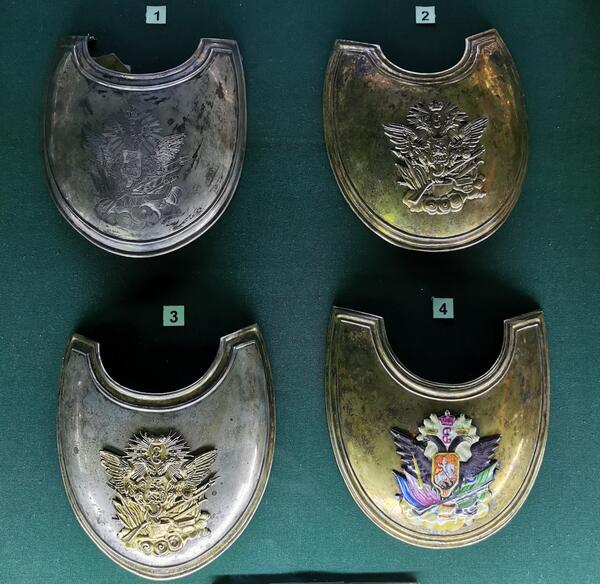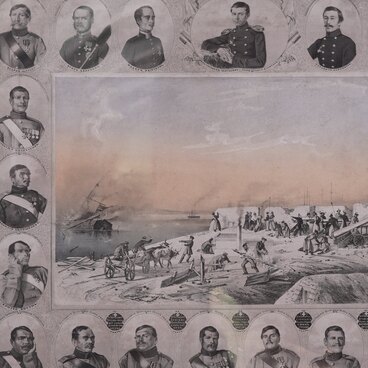In the late 17th century, the Russian army adopted neck (chest) badges with the image of the state coat of arms and the monogram of the reigning monarch which were based on the design of European chest insignia.
Historically, these badges — gorgets — were part of the knight’s armor and were intended to protect the chest and neck in battle. Over time, they lost their practical function, remaining only a symbol of distinction. A gorget could only be worn by infantry, artillery and engineering officers (they were not granted to cavalrymen).
Since 1701, the guards adopted a practice of granting insignia “by rank”. For the first time, badges of different colors for all officer ranks of the army began to be used in the Observation Corps. The coat of arms on the company officers’ gorgets was minted, and on the field officers’ ones it was detachable. Ensigns wore completely silver badges, adjutants and sub-lieutenants — silver with a gilded monogram of the empress and a crown, and lieutenants — silver with a gilded coat of arms. On the silver captain’s gorget, the coat of arms and the rim were gilded. Majors wore gilded badges, while the ones for lieutenant colonels were gilded with an enameled crown and monogram. Colonels were entitled to gilded gorgets with a colored enamel coat of arms. These insignia were worn on red or blue ribbons tied under the collar.
The Observation Corps was formed in 1756 on the initiative of Count Pyotr Ivanovich Shuvalov and in accordance with the decree of Elizabeth Petrovna dated from September 26. General Feldzeugmeister Shuvalov was appointed commander of the corps. He made sketches of the uniform and selected the personnel. According to his project, the corps was to include five numbered infantry (musketeer) regiments, one grenadier and one artillery regiment — a total of more than 30,000 people. Shuvalov proposed to equip each regiment with 18 guns, including 4 “secret howitzers” and 12 “Shuvalov unicorns”.
In reality, however, it was possible to recruit only 29,000 people. There was a lack of officers, and the lower ranks were heterogeneous (the Don Cossacks, Tatars, Montenegrins, Bashkirs, Mishar Tatars, young noblemen) and poorly trained. They were wanting in horses, carts, uniforms, guns and artillery pieces (98 instead of 144).
Count Shuvalov only formally led the Observation Corps, and was not stationed with it. The new military unit suffered serious losses in the Seven Years’ War at Zorndorf (August 1758) and Kunersdorf (August 1759) and was disbanded in 1760. The soldiers were divided into infantry units and three artillery regiments.
Officially, the Observation Corps ceased to exist in 1763.
Historically, these badges — gorgets — were part of the knight’s armor and were intended to protect the chest and neck in battle. Over time, they lost their practical function, remaining only a symbol of distinction. A gorget could only be worn by infantry, artillery and engineering officers (they were not granted to cavalrymen).
Since 1701, the guards adopted a practice of granting insignia “by rank”. For the first time, badges of different colors for all officer ranks of the army began to be used in the Observation Corps. The coat of arms on the company officers’ gorgets was minted, and on the field officers’ ones it was detachable. Ensigns wore completely silver badges, adjutants and sub-lieutenants — silver with a gilded monogram of the empress and a crown, and lieutenants — silver with a gilded coat of arms. On the silver captain’s gorget, the coat of arms and the rim were gilded. Majors wore gilded badges, while the ones for lieutenant colonels were gilded with an enameled crown and monogram. Colonels were entitled to gilded gorgets with a colored enamel coat of arms. These insignia were worn on red or blue ribbons tied under the collar.
The Observation Corps was formed in 1756 on the initiative of Count Pyotr Ivanovich Shuvalov and in accordance with the decree of Elizabeth Petrovna dated from September 26. General Feldzeugmeister Shuvalov was appointed commander of the corps. He made sketches of the uniform and selected the personnel. According to his project, the corps was to include five numbered infantry (musketeer) regiments, one grenadier and one artillery regiment — a total of more than 30,000 people. Shuvalov proposed to equip each regiment with 18 guns, including 4 “secret howitzers” and 12 “Shuvalov unicorns”.
In reality, however, it was possible to recruit only 29,000 people. There was a lack of officers, and the lower ranks were heterogeneous (the Don Cossacks, Tatars, Montenegrins, Bashkirs, Mishar Tatars, young noblemen) and poorly trained. They were wanting in horses, carts, uniforms, guns and artillery pieces (98 instead of 144).
Count Shuvalov only formally led the Observation Corps, and was not stationed with it. The new military unit suffered serious losses in the Seven Years’ War at Zorndorf (August 1758) and Kunersdorf (August 1759) and was disbanded in 1760. The soldiers were divided into infantry units and three artillery regiments.
Officially, the Observation Corps ceased to exist in 1763.




